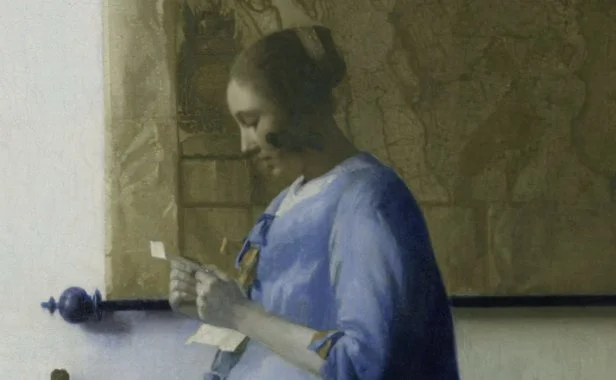The Beautiful in the Ordinary
Image taken from https://www.dailyartmagazine.com/johannes-vermeer-woman-reading-a-letter/ (DailyArt Magazine)
Recently, Google altered their logo to celebrate Dutch Baroque painter Johannes Vermeer, and seeing three of his works again was lovely as someone who loves to paint and learn about art history in my free time. Aside from his exquisite attention to detail and use of lighting in his paintings, Vermeer has always stuck in my mind due to his subject matter itself. Many of my favorite artists, and especially those successful up to and during Vermeer’s life in the 17th century, depicted magnificent moments in history, mythology, and religion. Throughout history, famous paintings have dealt with subjects which are already considered extraordinary in themselves, from raging battles full of legendary warriors to interactions between gods and men. Think of Michelangelo’s “Creation of Adam,” a piece wherein the Renaissance master strives to capture in brushstrokes the very beginning of human history, and which is viewed in person by millions of visitors every year in Rome. There is a temptation in art, and indeed a tradition, to attempt to portray those moments and figures which have “defined” humanity.
Contrary to the efforts of his forerunners and, I imagine, of his high-reaching peers, Vermeer’s art does not depict gods, or even those who were viewed as particularly “godly” men. His depictions of ordinary life stand out in art history as a homage to intimate moments, mostly between oneself and one’s work or between two individuals. His works feel private, almost like we are peering through a keyhole into a stranger’s home and personal routine - a woman patiently pouring milk, a man deep in thought while surveying a globe, a couple exchanging words at a table, smiling. Although Vermeer painted both women and men, he painted 42 women and only 13 men. Not a single one of those women is named.
While we might appreciate Vermeer’s depictions of daily life in the 17th century, it’s difficult to imagine Vermeer - or perhaps any artist - freely choosing to spend months of time layering expensive paints in an attempt to capture “modern” moments on canvas. Who would dedicate that kind of time and effort to frame a freshman pouring syrup from a plastic container onto his dining hall pancakes, or a student flipping through her psychology textbook at the library, or any group of individuals logging onto Zoom only to have their microphones muted for most of a meeting? In an age where so much more is easily recorded from a handheld device in our pockets, it can seem that the ordinary life which caught Vermeer’s attention has faded into something somehow even more ordinary, and unworthy of our attention. Especially in my experience with online learning, it often felt as though I were simply going through the motions, from one item to the next on my checklist and on my computer screen.
However, if there is one aspect of life that I think we have gained a greater appreciation for during the pandemic, it is the “normal,” or the ordinary. In the first Food for Thought module this semester, “How To Be a (Human) Student Again,” we discussed this in the context of learning itself. There are certain aspects to in-person classes and face-to-face interactions which are essential to life as a student, and without them, learning can feel empty and mechanical. For me, even just the extremely small parts of college life I didn’t expect to make an impact have shifted my vision of university life this semester, my first semester in person. I didn’t foresee the warm sunshine and crunchy leaves while I chat with a friend on my way to classes, the soft clinking of silverware and murmuring of voices early in the morning at the dining hall, or even just the impact of the physical presence of a professor and fellow students around me in the midst of lecture. The quantity of these ordinary moments does not make them any less valuable, and in my growing appreciation of these small blessings I have started to collect my own “paintings”: a photo in my camera roll of the pretty rainbow on the floor of the library, a snapshot of a croissant I bought at the campus cafe, another blurry image of the black squirrel I spot sometimes near College Hall. Even if I delete these photos later, taking the moment to savor these moments and recognize them as perhaps ordinary in their beauty, but still beautiful nonetheless, is a task and a way of living that I think Vermeer would appreciate.
